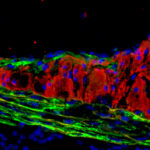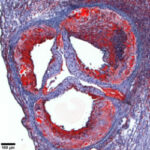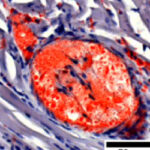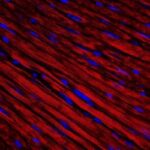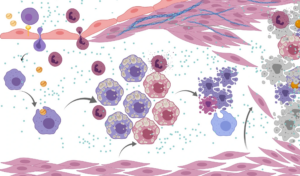
Atherosclerosis is a multifactorial disease driven by interactions between circulating lipoproteins, inflammatory cells and cells of the arterial wall. The disease results from dysregulated lipid metabolism and inflammation. Circulating low density lipoproteins (LDL) may be retained in the artery wall and chemically modified, triggering an inflammatory response resulting in the recruitment of monocytes. The monocytes are subsequently differentiated into macrophage foam cells, characterized by a buildup of cholesterol in the cytoplasm from the uptake of modified lipoproteins. The foam cells comprise fatty streaks in the arterial intima and develop into atherosclerotic plaque as the disease progresses. In late stages of atherosclerosis, a necrotic core forms in the plaque as a result of high rates of macrophage cell death and the defective clearance of dead cells. A large, lipid-rich necrotic core destabilizes the atherosclerotic plaque leading to plaque rupture, causing the formation of a thrombus and potentially leading to ischemia.
High density lipoproteins (HDL) counter the development of atherosclerosis through mediating reverse cholesterol transport, a process through which cholesterol is removed from the foam cells of the atherosclerotic plaque. HDL transports the cholesterol to the liver where hepatocytes secrete the cholesterol into the bile for reuptake or disposal. Reverse cholesterol transport is driven by ATP binding cassette transporters (ABCA1 and ABCG1) in macrophages and by the HDL receptor, scavenger receptor class B type 1 (SR-B1) in the liver. HDL also protects against atherosclerosis by activating signaling pathways in cells (like macrophages and endothelial cells) in the artery wall leading to atheroprotective responses.
In the Trigatti Lab, we are interested in investigating molecular pathways that drive the development of atherosclerosis. In particular, our ongoing projects focus on the role of the HDL receptor SR-B1 in protection against atherosclerosis in coronary arteries, the role of HDL signaling in modulating cell death within atherosclerotic plaques, other molecular pathways that modulate atherosclerosis development and the role of signaling by HDL in cardiomyocytes in protecting against cardiotoxicity.
Current Research
Learn more about our research focuses.

